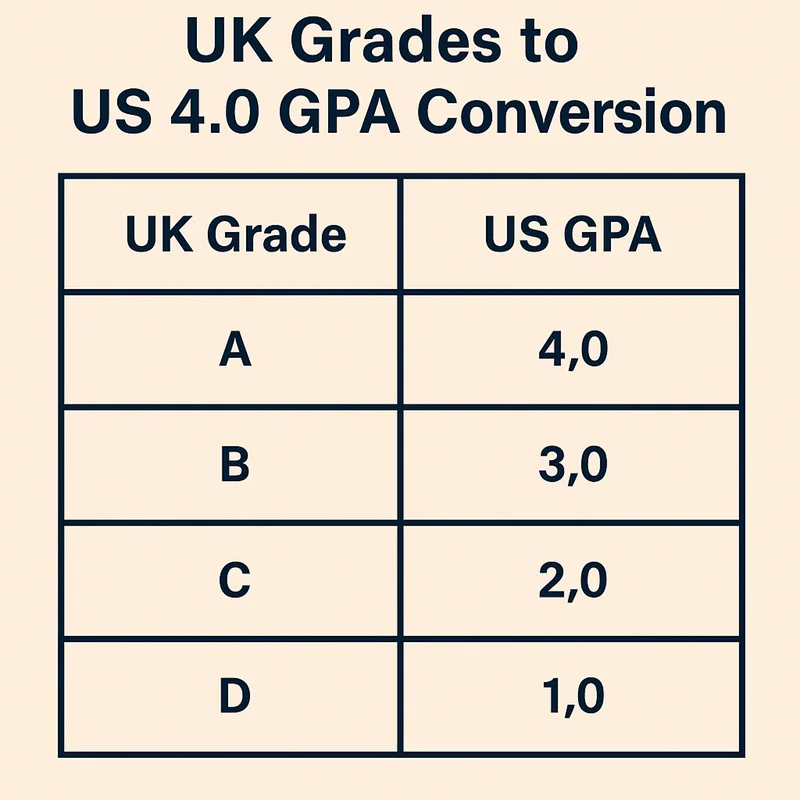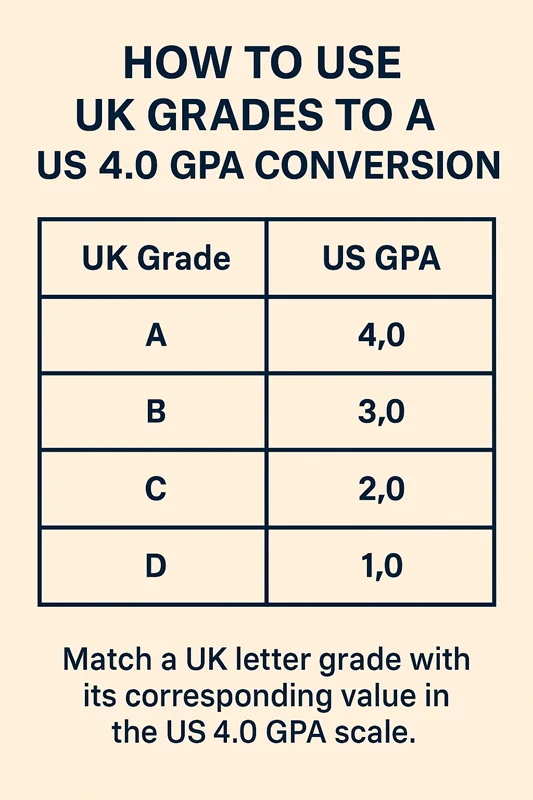Convert your UK degree classification to US GPA scale
This tool provides estimated GPA conversions only and should not be considered as an official evaluation. Different institutions and credential evaluation services may use varying conversion standards.
For formal academic evaluations, please consult professional credential evaluation services such as WES (World Education Services) or other NACES-accredited evaluators.
Converting UK grades to the US 4.0 GPA system can be challenging for students applying to American universities or seeking international opportunities. This comprehensive guide breaks down the conversion process for GCSE, A-Level, undergraduate, and postgraduate qualifications, providing accurate conversion tables and practical examples to help students navigate this complex process.
Students from the UK face unique challenges when applying to US institutions, as the grading systems differ significantly. UK universities typically use percentage-based marks and degree classifications, while US institutions rely on the standardized 4.0 GPA scale. Accurate conversion is crucial for:
The General Certificate of Secondary Education (GCSE) uses a 9-1 grading scale, where 9 represents the highest achievement:
Advanced Level (A-Level) qualifications use letter grades:
UK bachelor’s degrees are classified into four main categories:
Master’s degrees typically use:
The US Grade Point Average (GPA) system converts letter grades to numerical values on a 4.0 scale:
Many institutions also use plus/minus grades (A-, B+, etc.) with corresponding decimal adjustments (3.7, 3.3, etc.).
Determine whether you’re converting GCSE, A-Level, undergraduate, or postgraduate grades, as each uses different conversion methods.
Gather your official transcripts, certificates, or degree classification documents.
Use the specific conversion table for your qualification level (provided below).
For multiple subjects or modules, calculate the weighted average based on credit hours or subject importance.
Always check with your target US institution for their specific conversion guidelines, as methods can vary.

GCSE Grade | Percentage Range | US GPA Equivalent |
9 | 95-100% | 4.0 |
8 | 85-94% | 3.7-3.9 |
7 | 75-84% | 3.3-3.6 |
6 | 65-74% | 3.0-3.2 |
5 | 55-64% | 2.7-2.9 |
4 | 45-54% | 2.0-2.6 |
3 | 35-44% | 1.3-1.9 |
2 | 25-34% | 1.0-1.2 |
1 | Below 25% | 0.5-0.9 |
A-Level Grade | Percentage Range | US GPA Equivalent |
A* | 90-100% | 4.0 |
A | 80-89% | 3.7-3.9 |
B | 70-79% | 3.3-3.6 |
C | 60-69% | 3.0-3.2 |
D | 50-59% | 2.0-2.9 |
E | 40-49% | 1.0-1.9 |
U | Below 40% | 0.0 |
UK Classification | Percentage Range | US GPA Equivalent |
First Class (1st) | 70-100% | 3.7-4.0 |
Upper Second (2:1) | 60-69% | 3.3-3.6 |
Lower Second (2:2) | 50-59% | 2.7-3.2 |
Third Class (3rd) | 40-49% | 2.0-2.6 |
Pass/Ordinary | Below 40% | 1.0-1.9 |
UK Classification | Percentage Range | US GPA Equivalent |
Distinction | 70-100% | 3.8-4.0 |
Merit | 60-69% | 3.3-3.7 |
Pass | 50-59% | 2.7-3.2 |
Fail | Below 50% | Below 2.0 |
Sarah achieved the following A-Level grades:
Calculated GPA: (4.0 + 3.8 + 3.5) ÷ 3 = 3.77 GPA
James graduated with a 2:1 degree in Engineering with an overall mark of 65%.
Conversion: 65% falls within the 2:1 range (60-69%), which typically converts to 3.4-3.5 GPA.
Emma achieved the following GCSE grades:
Calculated GPA: (3.8 + 4.0 + 3.4 + 3.1 + 3.4) ÷ 5 = 3.54 GPA
WES provides official credential evaluations for international students. Their UK degree GPA conversion typically follows these guidelines:
ECE offers similar services with slight variations in conversion ranges. They consider factors such as:
Different US universities may have varying conversion standards. Some factors that influence conversion include:
UK grading systems are generally considered more stringent than US systems. A UK first-class degree (70%+) represents exceptional achievement, while a US A-grade (90%+) is more commonly awarded.
Some subjects may have different conversion standards:
Many US institutions require official transcript evaluations from recognized services. Self-calculated conversions may not be accepted for:

Online UK GPA calculators provide estimates but may not reflect specific institutional requirements. Professional evaluation services offer more reliable conversions for official purposes.
Yes, individual module marks can be converted using percentage-based conversion tables. However, overall degree classification often carries more weight in admissions decisions.
Most US universities are familiar with both systems. Providing both percentage marks and GPA conversions can offer clarity and transparency in applications.
A UK 2:1 degree typically converts to a 3.3-3.6 GPA, which is considered competitive for most US graduate programs and employment opportunities.
Predicted grades should be clearly labeled as such and not included in official GPA calculations. Use only confirmed, official results for accurate conversions.
Scottish Highers and Advanced Highers follow similar conversion principles to A-Levels, with grades A-D converting to appropriate GPA ranges (4.0-2.0).
Pass/fail modules typically don't contribute to GPA calculations. Focus on graded modules and overall degree classification for conversion purposes.
Converting UK Grades to a US 4.0 GPA Conversion system requires understanding both educational frameworks and applying appropriate conversion methods. While the conversion tables and examples provided offer reliable guidance, students should always verify requirements with their target institutions and consider professional evaluation services for official applications.
The key to successful grade conversion lies in understanding that UK and US grading systems reflect different educational philosophies and standards. UK grades often represent more stringent assessment criteria, which should be considered when interpreting GPA conversions.
For the most accurate conversions, students should consult with admissions counselors, use professional evaluation services, and provide comprehensive documentation of their academic achievements. This approach ensures that UK qualifications are properly recognized and valued in the US educational and professional landscape.
Ready to convert your grades? Use the conversion tables above as a starting point, but remember to verify with your target institution’s specific requirements. Consider professional evaluation services for official applications and don’t hesitate to contact admissions offices for clarification on their conversion policies.